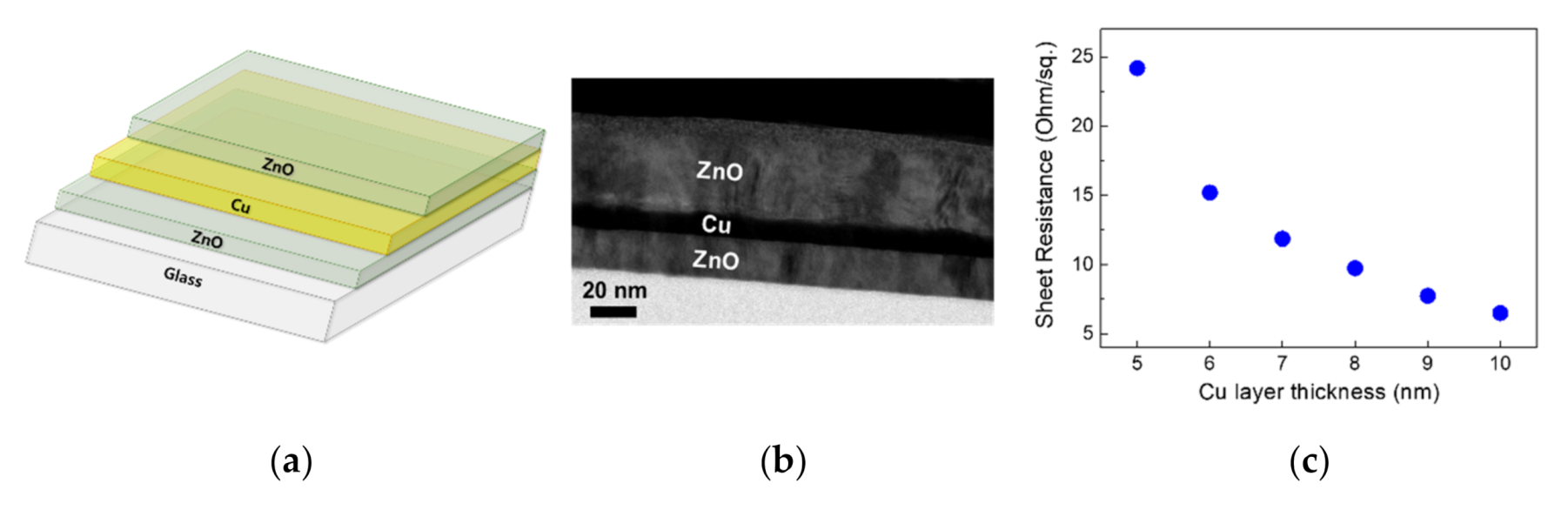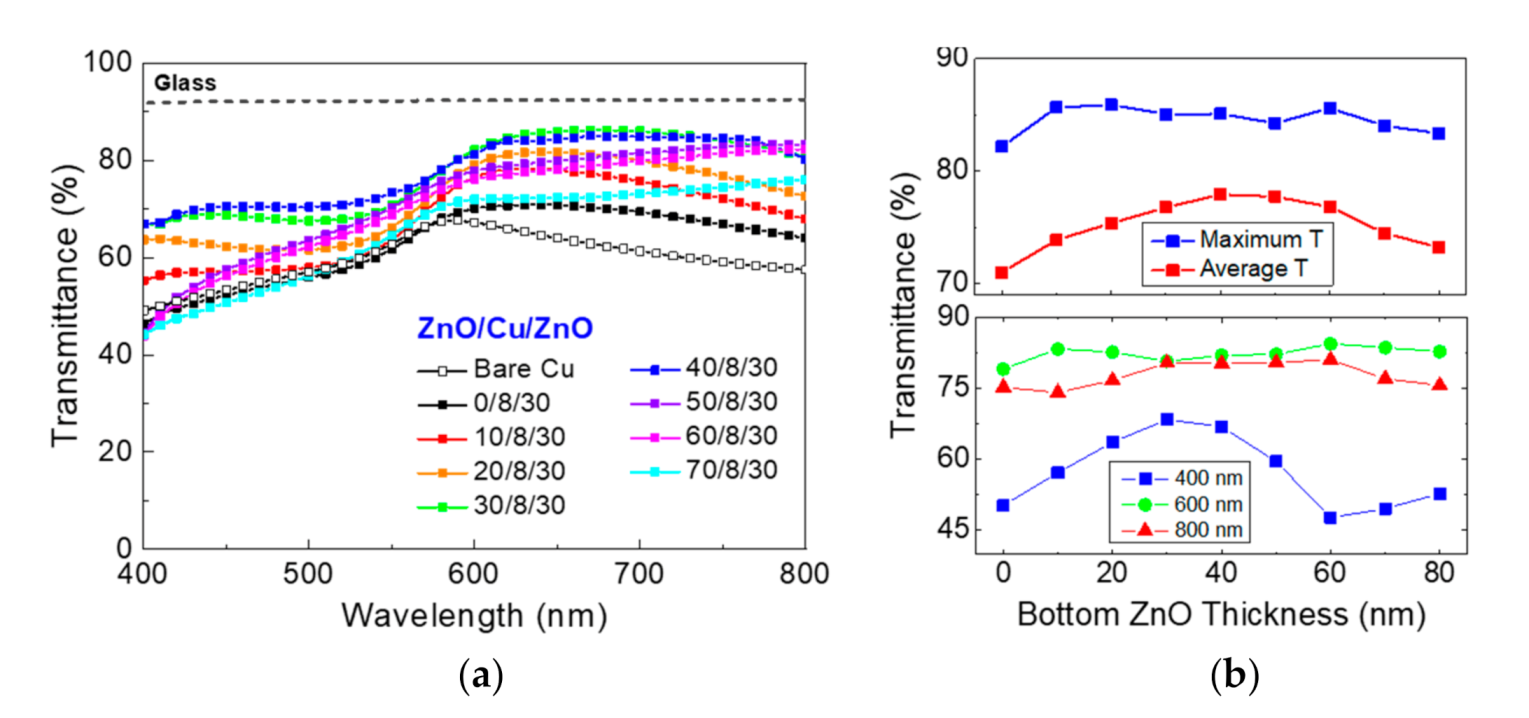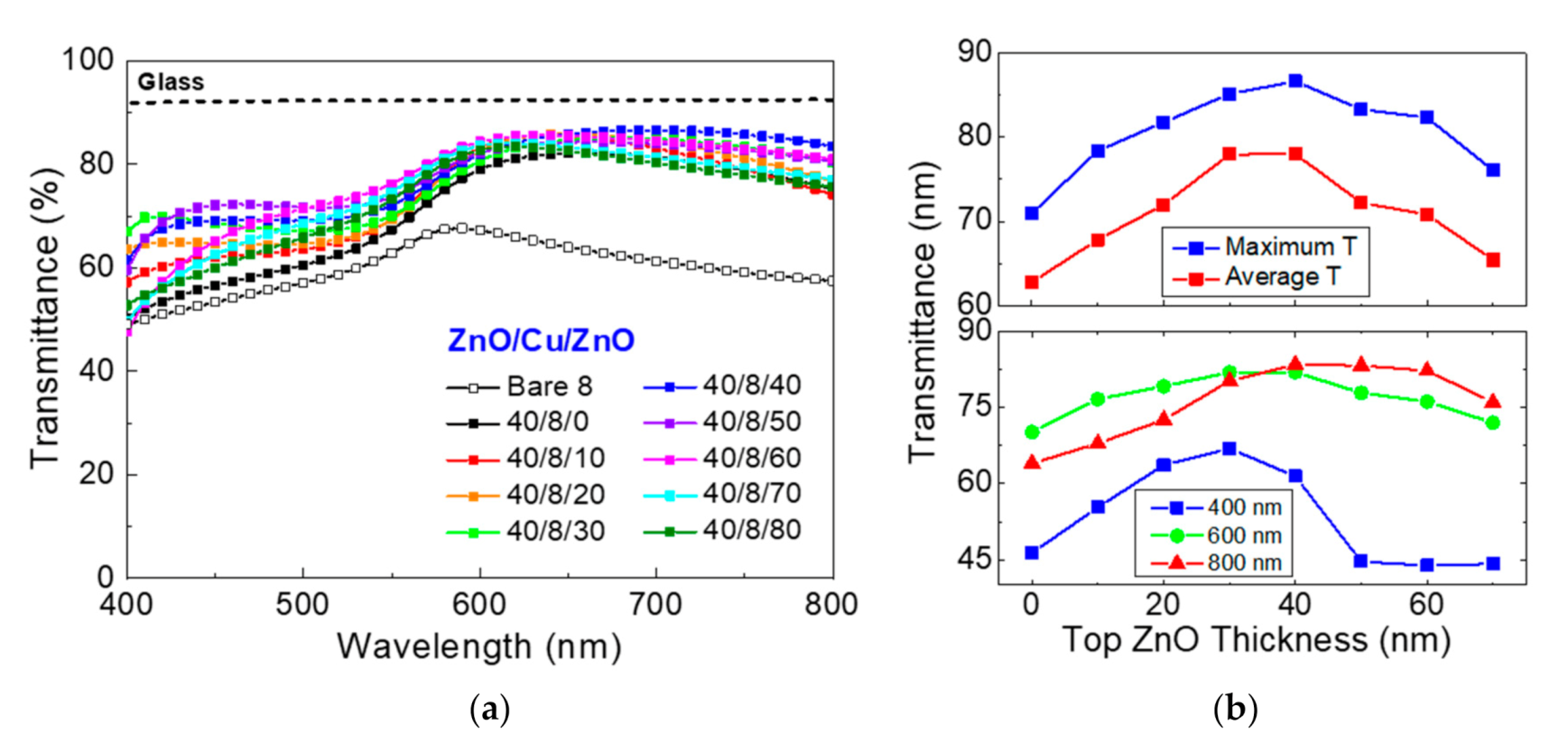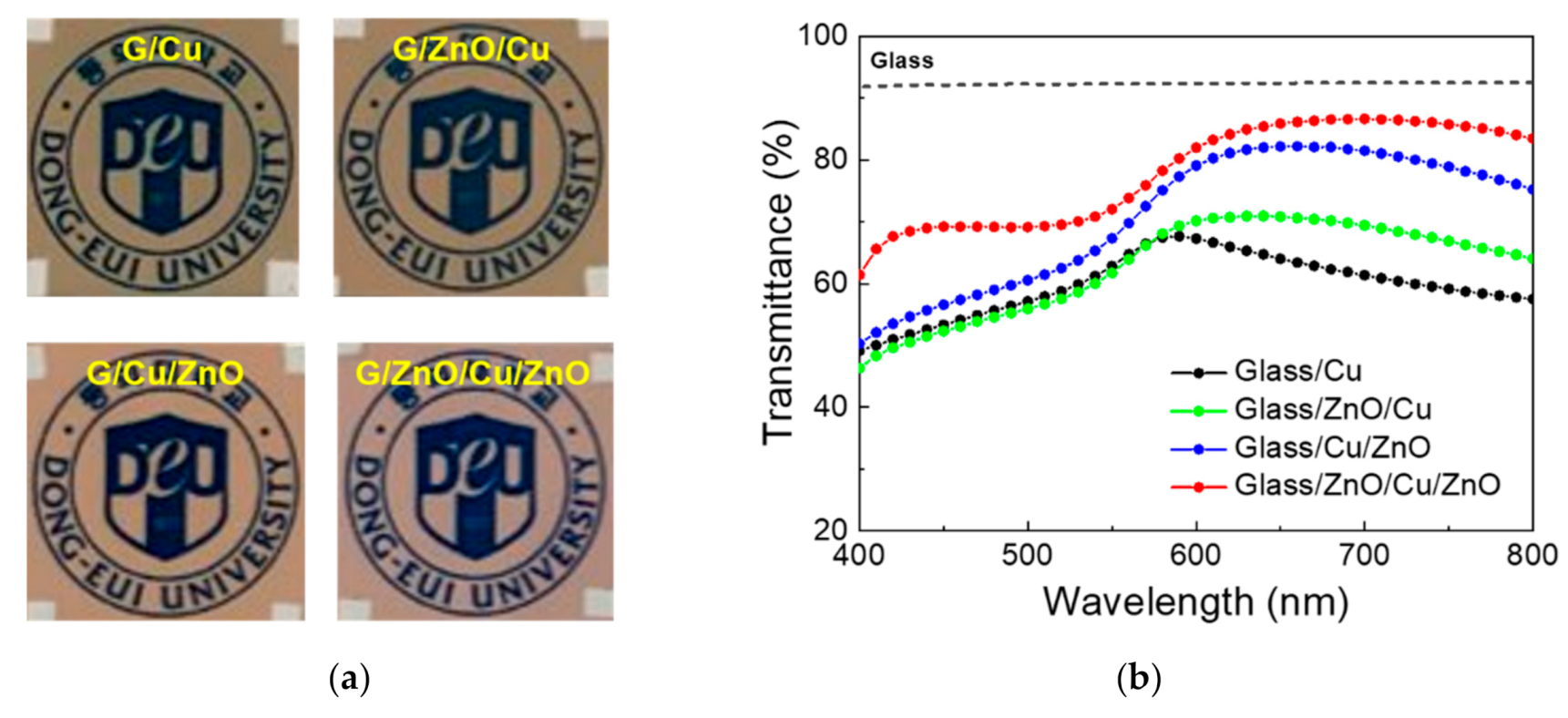The Transmittance Modulation of ZnO/Cu/ZnO Transparent Conductive Electrodes Prepared on Glass Substrates
Abstract
1. Introduction
2. Experiment
3. Results and Discussion
4. Conclusions
Funding
Conflicts of Interest
References
- Ellmer, K. Past achievements and future challenges in the development of optically transparent electrodes. Nat. Photonics 2012, 6, 809–817. [Google Scholar] [CrossRef]
- Roldán-Carmona, C.; Malinkiewicz, O.; Soriano, A.; Espallargas, G.M.; García, A.; Reinecke, P.; Kroyer, T.; Dar, M.I.; Nazeeruddin, M.K.; Bolink, H.J. Flexible high efficiency perovskite solar cells. Energy Environ. Sci. 2014, 7, 994–997. [Google Scholar] [CrossRef]
- Park, S.; Park, H.; Kim, D.; Yang, J.; Lee, D.; Kim, Y.-S.; Kim, H.-J.; Suh, D.; Min, B.K.; Kim, K.N.; et al. Optimization of controllable factors in the aluminum silicon eutectic paste and rear silicon nitride mono-passivation layer of PERC solar cells. Met. Mater. Int. 2018, 24, 664–671. [Google Scholar] [CrossRef]
- Kim, H.; Gilmore, C.M.; Piqué, A.; Horwitz, J.; Mattoussi, H.; Murata, H.; Kafafi, Z.; Chrisey, D. Electrical, optical, and structural properties of indium-tin-oxide thin films for organic light-emitting devices. J. Appl. Phys. 1999, 86, 6451–6461. [Google Scholar] [CrossRef]
- Betz, U.; Kharrazi Olsson, M.; Marthy, J.; Escolá, M.F.; Atammny, F. Optimization of ZnO/Ag/ZnO transparent conductive electrodes fabricated by magnetron sputtering. Surf. Coat. Technol. 2006, 200, 5751. [Google Scholar] [CrossRef]
- Chaparro, A.M.; Martínez, M.; Guillén, C.; Bayón, R.; Gutiérrez, M.; Herrero, J. SnO2 substrate effects on the morphology and composition of chemical bath deposited ZnSe thin films. Thin Solid Films 2000, 361, 177–182. [Google Scholar] [CrossRef]
- Chen, R.; Das, S.R.; Jeong, C.; Khan, M.R.; Janes, D.B.; Alam, M.A. Co-percolating graphene-wrapped nilver nanowire network for High performance, highly stable, transparent conducting electrodes. Adv. Funct. Mater. 2013, 23, 5150–5158. [Google Scholar] [CrossRef]
- Li, X.; Zhu, Y.; Cai, W.; Borysiak, M.; Han, B.; Chen, D.; Piner, R.D.; Colombo, L.; Ruoff, R.S. Transfer of large-area graphene films for high-performance transparent conductive electrodes. Nano Lett. 2009, 9, 4359–4363. [Google Scholar] [CrossRef]
- Guo, C.F.; Ren, Z. Flexible transparent conductors based on metal nanowire networks. Mater. Today 2015, 18, 143–154. [Google Scholar] [CrossRef]
- Nayak, P.K. Pulsed-grown graphene for flexible transparent conductors. Nanoscale Adv. 2019, 1, 1215–1223. [Google Scholar] [CrossRef]
- Wu, H.; Kong, D.; Ruan, Z.; Hsu, P.-C.; Wang, S.; Yu, Z.; Carney, T.J.; Hu, L.; Fan, S.; Cui, Y. A transparent electrode based on a metal nanotrough network. Nat. Nanotechnol. 2013, 8, 421–425. [Google Scholar] [CrossRef]
- Yin, Z.; Song, S.K.; You, D.-J.; Ko, Y.; Cho, S.; Yoo, J.; Park, S.Y.; Piao, Y.; Chang, S.T.; Kim, Y.S. Novel synthesis, coating, and networking of curved copper nanowires for flexible transparent conductive electrodes. Small 2015, 11, 4576–4583. [Google Scholar] [CrossRef]
- Xia, Y.; Sun, K.; Ouyang, J. Solution-processed metallic conducting polymer films as transparent electrode of optoelectronic devices. Adv. Mater. 2012, 24, 2436–2440. [Google Scholar] [CrossRef]
- Kang, H.; Jung, S.; Jeong, S.; Kim, G.; Lee, K. Polymer-metal hybrid transparent electrodes for flexible electronics. Nat. Commun. 2015, 6, 6503. [Google Scholar] [CrossRef]
- Wang, W.; Song, M.; Bae, T.-S.; Park, Y.H.; Kang, Y.-C.; Lee, S.-G.; Kim, S.-Y.; Kim, D.H.; Lee, S.; Min, G.; et al. Transparent ultrathin oxygen-doped silver electrodes for flexible organic solar cells. Adv. Funct. Mater. 2013, 24, 1551–1561. [Google Scholar] [CrossRef]
- Zhang, C.; Zhao, D.; Gu, D.; Kim, H.; Ling, T.; Wu, Y.-K.R.; Guo, L.J. An ultrathin, smooth, and low-loss Al-doped Ag film and its application as a transparent electrode in organic Photovoltaics. Adv. Mater. 2014, 26, 5696–5701. [Google Scholar] [CrossRef]
- Zhao, G.; Wang, W.; Bae, T.-S.; Lee, S.G.; Mun, C.; Lee, S.; Yu, H.; Lee, G.-H.; Song, M.; Yun, J. Stable ultrathin partially oxidized copper film electrode for highly efficient flexible solar cells. Nat. Commun. 2015, 6, 8830. [Google Scholar] [CrossRef]
- Rathmell, A.R.; Wiley, B.J. The synthesis and coating of long, thin copper nanowires to make flexible, transparent conducting films on plastic substrates. Adv. Mater. 2011, 23, 4798–4803. [Google Scholar] [CrossRef]
- Loka, C.; Moon, S.W.; Choi, Y.; Lee, K.S. High transparent and conductive TiO2/Ag/TiO2 multilayer electrode films deposited on sapphire substrate. Electron. Mater. Lett. 2018, 14, 125–132. [Google Scholar] [CrossRef]
- Lin, Q.; Yang, S.; Jing, W.; Wang, C.; Jiang, Z.; Qijing, L.; Shuming, Y.; Weixuan, J.; Chenying, W.; Zhuangde, J. Numerical simulation on optical Characteristics of ZnO/Cu/ZnO thin film. J. Nanosci. Nanotechnol. 2016, 16, 873–877. [Google Scholar] [CrossRef]
- Aspnes, D.E. Optical properties of thin films. Thin Solid Films 1982, 89, 249–262. [Google Scholar] [CrossRef]
- Ball, J.T.; Ball, B.J. Photovoltaic Module with Heater. U.S. Patent 0037215, 16 February 2012. [Google Scholar]
- Jo, H.S.; An, S.; Lee, J.-G.; Park, H.G.; Al-Deyab, S.S.; Yarin, A.L.; Yoon, S.S. Highly flexible, stretchable, patternable, transparent copper fiber heater on a complex 3D surface. NPG Asia Mater. 2017, 9, e347. [Google Scholar] [CrossRef]
- Cheong, W.-S.; Kim, Y.-H.; Lee, J.-M.; Hong, C.-H.; Choi, H.-Y.; Kwak, Y.-J.; Kim, Y.J.; Kim, Y.S. High-performance transparent electrodes for automobile windshield heaters prepared by combining metal grids and oxide/metal/oxide transparent electrodes. Adv. Mater. Technol. 2019, 4, 1800550. [Google Scholar] [CrossRef]






| Sample No. | Layer Thickness (nm) | Visible Light Transmittance | |||
|---|---|---|---|---|---|
| Bottom ZnO | Cu | Top ZnO | Max (Wavelength) | Average (λ: 400–800 nm) (%) | |
| 1 | 0 | 8 | 0 | 76.5 (590 nm) | 68.8 |
| 2 | 0 | 30 | 91.1 (650 nm) | 80.5 | |
| 3 | 10 | 94.5 (640 nm) | 83.2 | ||
| 4 | 20 | 94.7 (650 nm) | 84.6 | ||
| 5 | 30 | 93.9 (680 nm) | 85.3 | ||
| 6 | 40 | 94.0 (670 nm) | 87.1 | ||
| 7 | 50 | 93.1 (670 nm) | 87.1 | ||
| 8 | 60 | 94.4 (640 nm) | 86.5 | ||
| 9 | 70 | 92.9 (620 nm) | 84.0 | ||
| 10 | 80 | 92.3 (620 nm) | 82.7 | ||
| 11 | 40 | 0 | 79.7 (630 nm) | 72.1 | |
| 12 | 10 | 87.1 (630 nm) | 77.0 | ||
| 13 | 20 | 90.6 (650 nm) | 81.0 | ||
| 14 | 30 | 94.0 (670nm) | 87.1 | ||
| 15 | 40 | 95.4 (700 nm) | 87.4 | ||
| 16 | 50 | 92.0 (790 nm) | 82.1 | ||
| 17 | 60 | 91.1 (790 nm) | 80.6 | ||
| 18 | 70 | 84.8 (800 nm) | 75.1 | ||
© 2020 by the author. Licensee MDPI, Basel, Switzerland. This article is an open access article distributed under the terms and conditions of the Creative Commons Attribution (CC BY) license (http://creativecommons.org/licenses/by/4.0/).
Share and Cite
Choi, D. The Transmittance Modulation of ZnO/Cu/ZnO Transparent Conductive Electrodes Prepared on Glass Substrates. Materials 2020, 13, 3916. https://doi.org/10.3390/ma13183916
Choi D. The Transmittance Modulation of ZnO/Cu/ZnO Transparent Conductive Electrodes Prepared on Glass Substrates. Materials. 2020; 13(18):3916. https://doi.org/10.3390/ma13183916
Chicago/Turabian StyleChoi, Dooho. 2020. "The Transmittance Modulation of ZnO/Cu/ZnO Transparent Conductive Electrodes Prepared on Glass Substrates" Materials 13, no. 18: 3916. https://doi.org/10.3390/ma13183916
APA StyleChoi, D. (2020). The Transmittance Modulation of ZnO/Cu/ZnO Transparent Conductive Electrodes Prepared on Glass Substrates. Materials, 13(18), 3916. https://doi.org/10.3390/ma13183916




